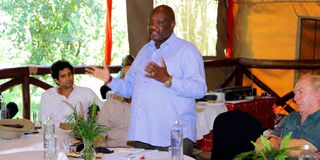
Narok Governor Samuel Tunai addresses tourism industry players from Kenya and Tanzania on January 23, 2021.
Kenya and Tanzania will conduct a joint cross-border census of rhinos and other large mammals in the
shared Mara-Serengeti ecosystem.The census is one of the resolutions reached by a joint three-day meeting of tourism industry players from the two countries at the Mara Serena Safari Lodge.
The meeting was held under the auspices of the Greater Serengeti Society platform and was chaired by Narok governor Samuel Tunai.
“We deliberated on the successes so far [made] in conservation of the Greater Serengeti ecosystem as well as existing challenges and various interventions needed,” added Mr Tunai.
Mr Tunai is the chairman of the Tourism and Natural Resources Management Committee of the Council of Governors (CoG).
The European Union funded the meeting that was attended by senior managers and directors from Tanzania’s national parks, Kenya Wildlife Service (KWS) director of national reserves and Tanzania’s Wildlife Management Authority.
Mr Tunai said the meeting formed a committee to prepare for the cross-border census involving KWS, Narok County rangers, Tanzania Wildlife Research Institute, Wildlife Division of Tanzania, the country’s national parks and NGOs.
The aerial census will seek to establish the wildlife population, trends and distribution and to foster cross-border collaboration on wildlife monitoring and management between the two East African countries.
Information gathered from the census will establish how many rhinos there are.
“The data will be used for planning and preparing the management for possible wildlife security and human-wildlife conflict eventualities in the ecosystem,” Mr Tunai said.
Stakeholders also sought solutions for major management concerns for the Greater Serengeti, including issues regarding the Mara River, land-use change and managing the boundaries, tourism, illegal activity and human-wildlife co-existence.
Mr Tunai gave the CoG’s commitment to cooperate with the Tourism ministry and work jointly with all stakeholders to ensure that both countries use all the necessary resources – human, technical and material – to conserve and sustain the Greater Mara-Serengeti ecosystem.
Ban fencing
Poaching, boundary challenges, management of land-use changes, climate change and environmental challenges were also discussed.
“We shall do more to involve local communities, and have them benefit even more from tourism resources. We’ve established a roadmap for effective sustainable management of the ecosystem,” Mr Tunai said.
Participants from Kenya petitioned the government to ban fencing, saying, it poses a threat to the ecosystem.
Maasai Mara Conservancies Association CEO Daniel Sopia raised concern over the fencing of private land around the reserve, saying, it interferes with wildlife corridors.
“We should create a precautionary zoning of conservation area under a special plan to deal with the fencing and mushrooming population in order to protect conservation areas,” he said.
“Owing to land fragmentation and subdivision of group ranches, owners have sold or leased their land to private developers, who have been fencing them to ward off wildlife,” he said.
Meanwhile, after decades of struggling to help Serengeti National Park wildlife cope with Tanzania’s increasingly intense droughts, the government is implementing a plan to use Lake Victoria as an alternative water source for animals after relocating people from three villages between the reserve and the lake.
Dr Grant Hopcraft, a researcher, said that the government of Tanzania has moved about 8,000 people out of the Speke Game Controlled Area in Bunda district in a bid to conserve the Serengeti ecosystem as it faces worsening drought.
The researcher said that the project aims to ensure the survival of millions of animals, including wildebeests and zebras that take part in the Great Migration every year.
He added that the project involves reviving a 36 sq km (14 sq mile) wildlife corridor by extending the border of the park to Lake Victoria’s Gulf of Speke.
The idea of moving people out of migratory routes was discussed at length, with proposals tabled for the same to be implemented in Kenyan.





No comments :
Post a Comment